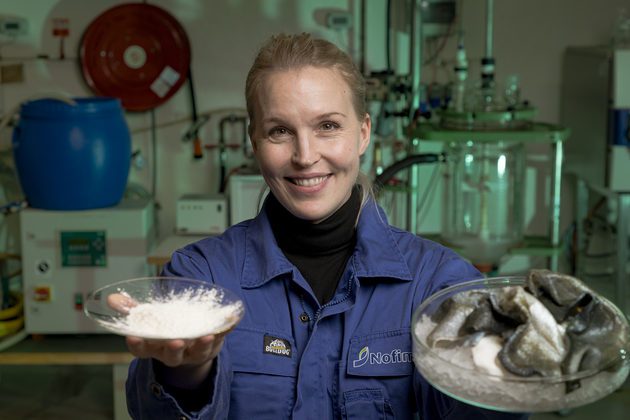Fish waste – from problem to valuable resources

Researchers from Europe come together in Tromsø to discuss how to utilize residual biomass from fish. What used to be considered waste will now be turned into useful ingredients with potential health benefits.
The fisheries industry currently produces large amounts of fish byproducts during the processing and production of fillets. Skin, bones and other remains are not as appealing to eat or sell. To avoid wasting this potential resource, the EU-project EcoeFISHent works to develop solutions to better utilize fish waste.
It has now been discovered that this residual biomass contains interesting ingredients that both have health benefits and can be utilised in cosmetics and in food packaging.
EU scientists on a study tour in Tromsø
It is mainly Italians who have arrived in Tromsø. They have sent boxloads of fish waste to Nofima researchers to find out which substances can be extracted and will now visit Biotep – Nofima’s pilot production plant – where fish remains are being processed in large scale.

Nofima project manager Kjersti Lian says she is looking forward to showcasing the Biotep plant.
“We are very proud of the production facility in Kaldfjorden and all our achievements there. The fish residue from Italy is turned into powder that we can use for ingredients with health benefits, and this can be done at a large scale at Biotep”.
From waste to lucrative resources

Researchers in Tromsø are working to optimize the extraction of protein and oil from fish byproducts from the Italian aquaculture industry. The process is then scaled up at Biotep.
Nofima researcher Marte Jenssen says:
“This project focuses on making the Italian fisheries and aquaculture industry more circular. The idea is to make the most of the raw materials that we already have to create products with the highest possible value.”
“We are particularly interested in substances such as collagen and other proteins”, she adds.
Jenssen also says that they have tested different methods for efficiently extracting lucrative substances from the fish waste.
“We particularly enjoyed deep-diving into a raw material that we have not worked on before. The byproducts from Italy consist of unsorted fish remains, which makes it extra challenging to retrieve relevant components.”
This EU project aims to make greater use of this residual biomass, and Jenssen and Lian are happy to be assisting their Italian colleagues in this process. They also encourage stakeholders from the Norwegian fisheries industry to reach out if they have byproducts they cannot use.
Publications
Facts about the research
The goal of this project is to achieve a more sustainable utilization of marine by-products in northwestern Italy through cooperation between fisheries and agricultural stakeholders in the region.
Files and Links

